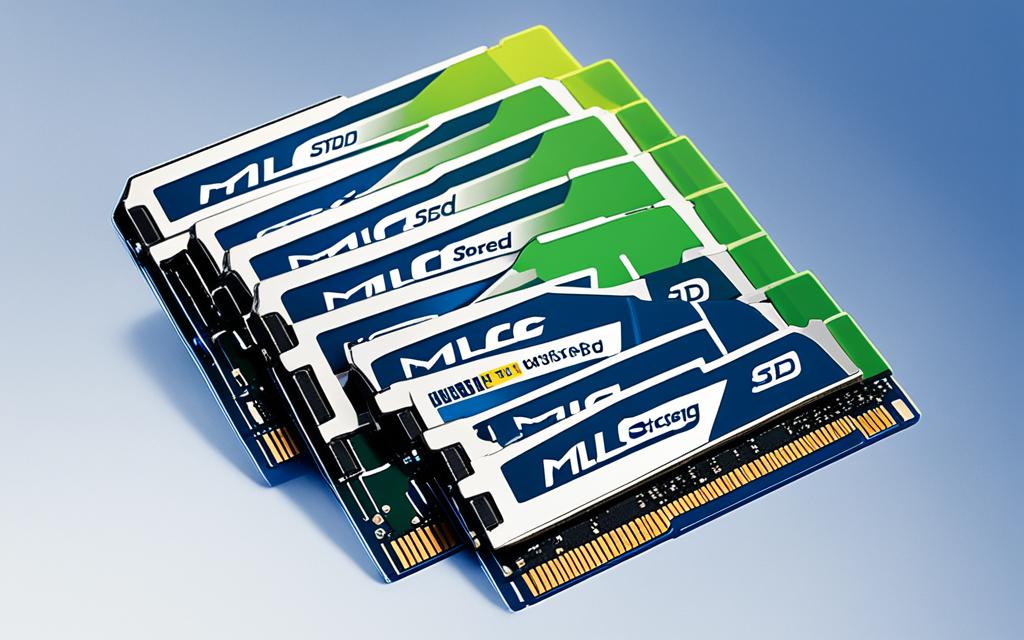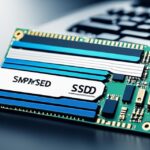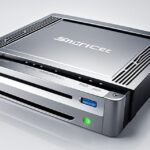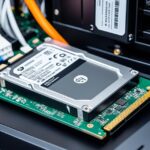Table of Contents
A multi-level cell (MLC) solid state drive (SSD) marks a significant step forward in how we store data. It can hold two bits per memory cell. This feature sets MLC SSDs apart from single-level cell (SLC) drives, which store only one bit. By adopting a four-state design, MLC SSDs offer a good mix of storage size and speed. This makes them appealing for gadgets and computers. As more people look for better and cheaper storage, MLC SSDs are now a top pick for many, from thumb drives to big business storage solutions123.
Key Takeaways
- MLC SSDs store two bits of information per cell, providing a balance of capacity and performance.
- They are more affordable than SLC SSDs while offering improved data density.
- MLC technology is widely used in consumer electronics and enterprise solid state drives.
- Compared to TLC SSDs, MLC SSDs exhibit faster read and write speeds.
- Reliability concerns arise due to bit error rates and potential data loss in SSDs.
- Popular MLC SSDs include models like the Samsung 860 Pro and SK hynix Gold.
Understanding Solid State Drives
Solid state drives (SSDs) are a big step forward in SSD technology. They offer huge improvements over old hard disk drives (HDDs). SSDs use NAND flash memory, which helps your computer access data faster. This is really important in our world that loves data. One great thing about SSDs is they don’t have moving parts. This means they are more robust and use less power.
When you compare SSDs to HDDs, SSDs are quicker. This is great for things like gaming and business needs. SSDs come in different types, such as SLC, MLC, TLC, and QLC. Each type offers a balance between how well it performs, how much it can store, and how much it costs.
For example, MLC SSDs can store two bits per cell, while SLC SSDs store one. This affects how long the SSD can last. MLC drives can handle up to 10,000 Program/Erase cycles. But SLC drives can reach a notable 100,000 cycles. This shows the different reliability levels among SSD technologies456.
Key Advantages of Solid State Drives:
- Faster data access speeds
- Improved durability and reliability
- Lower power consumption
- Scalability in various applications
SSDs have become popular because they are efficient and perform well. They are now the top choice for storage in computers. With the advancements in SSD technology, it’s important to know the differences among SSD types. This helps users make smart decisions for their needs.
What is MLC SSD
Multilevel Cell (MLC) SSD technology has changed how we store data. It lets us put more bits of data in each cell. This makes MLC SSDs store more data than other SSDs.
Definition of MLC SSD
MLC SSDs can store two bits of information in every cell. This is different from Single-Level Cell (SLC) SSDs, which store just one bit. MLC SSDs offer more storage for less money. They became a key part in making SSDs common in laptops and desktops. They can be used up to 10,000 times before they wear out. This makes them a favourite for those who need reliable performance but don’t want to pay a lot7.
Comparison with SLC and TLC SSDs
Comparing MLC to SLC, it’s important to know SLC lasts longer but costs more7. MLC and TLC SSDs are different too. TLC SSDs are cheaper but don’t last as long. But, MLC SSDs offer a good mix of price and durability. This is why many people prefer them. Leading brands like Samsung use MLC, TLC, and V-NAND SSDs to meet different business needs8.
Advantages of MLC SSDs
MLC SSDs shine in the world of storage. They bring big benefits for different kinds of users. Known for being both cost-effective and packing more data, they’re ideal for a variety of uses.
Cost Efficiency
When it comes to saving money, MLC SSDs stand out. They hold 2 bits of data per memory cell. This makes them more budget-friendly compared to SLC SSDs. But, the lower price doesn’t mean slower speeds. MLC SSDs work quickly, perfect for tougher tasks9. They offer a good mix of speed and sturdiness without costing too much. This makes them a top choice for those needing both efficiency and durability10.
Higher Data Density
MLC SSDs also excel in how much data they can store. They fit more bits into each memory cell. This tech allows them to hold more data without being pricey. This is great for jobs that need a lot of storage, like content creation or managing big databases. MLC SSDs last longer too, surviving about 10,000 use cycles11. Their long life and stable performance make them the go-to for demanding tasks.
MLC SSDs strike a perfect balance between saving costs and storing lots of data. This makes them a smart pick for both personal and professional settings.
Disadvantages of MLC SSDs
MLC SSDs are known for being cost-effective and holding more data. However, they have significant downsides that affect their speed and reliability. Their design lets each memory cell store several bits, making them complex. This complexity can make writing data slower when compared to single-bit SLC SSDs, which are faster.
Performance Limitations
MLC SSDs store bits in pairs, which increases the chance of errors. These errors can slow down the drive, especially during heavy use. Users might notice delays and sluggishness when loading programs or files. MLC SSDs also wear out faster than SLC SSDs, lasting about 10,000 cycles. They’re cheaper but pose trade-offs in performance and lifespan12.
Reliability Concerns
MLC drives are prone to wear and tear because of their complex structure. This means they can hold lots of data but also have a higher risk of losing it. Despite being able to handle 700 Terabytes, real-life usage can degrade them quicker than SLC drives13. Those using MLC SSDs for important tasks should remember their limited longevity and speed.
How MLC SSDs Operate
MLC SSDs work by using different charge states in each NAND flash memory cell to store data. Each cell can take on four voltage states, storing two bits of data. MLC SSDs can store more data than Single-Level Cell (SLC) SSDs because of this14. Although they offer lots of storage, MLC SSDs tend to be slower and less durable due to all the data writing13.
These SSDs also use advanced error correction to keep data safe. Even though MLC SSDs can hold more, all NAND flash memories wear out over time. Special algorithms work to make MLC SSDs last longer, which is key for demanding uses15.
In short, the balance of performance, cost, and energy use is key for MLC SSDs. They fit well in many places, needing high storage but not the highest durability of SLC drives14.
Reliability of MLC SSDs
To understand the reliability of MLC SSDs, we need to look at their operational features. Compared to SLC SSDs, they are designed differently, have varied storage capacities, and are used in different ways. These differences are important when we’re thinking about how reliable MLC SSDs are.
Comparative Reliability to SLC SSDs
Many think MLC SSDs are not as good as SLC SSDs. This is because MLC SSDs can handle less data before they start to wear out. SLC SSDs can save one bit per cell, making them very reliable. MLC SSDs, however, save two bits per cell. This means they are a bit slower and don’t last as long16. But, real-world use shows MLC SSDs can still perform well. For example, ATP’s A650Si/A650Sc Series slow down to match MLC SSDs’ reliability but work in a mode that’s normally worse17.
Factors Influencing SSD Failures
Several things can make SSDs fail more often. These include how they’re used, their environment, and how much work they do. Temperature, workload, and repeated data writing can really stress them out. ATP’s A750Pi Series shows that some tech can really help. It works 50% better in a specific mode than normal17.
The Samsung 860 Evo also shows that some SSDs can be very reliable. Its high ratings for total bytes written (TBW) are a good example16. It’s important to remember that how you use and where you put your SSD matters as much as its specs.
Applications of MLC SSDs
MLC SSDs are well-known for their good balance between performance and storage capacity. They are used widely in different sectors. This makes them a great choice for both personal and business needs.
Best Use Cases
MLC SSDs are perfect for situations that need quick data access but can’t afford the high cost of SLC SSDs. They are ideal in content creation, where fast data access and enough storage are key. In gaming, these SSDs ensure a smooth experience.
They are also used in enterprise servers. This is because they manage large data well and are cost-effective.
Industries Benefiting from MLC Technology
Many industries benefit from using MLC SSDs. The media and entertainment industry uses them for fast video editing and rendering. In healthcare, they speed up access to medical records.
Similarly, the manufacturing industry relies on them for monitoring systems that need quick data processing. MLC SSDs’ wide applications show how important they are in today’s world.
| Industry | Use Case | Benefits of MLC SSDs |
|---|---|---|
| Media and Entertainment | Video Editing | Improves productivity with fast data access |
| Healthcare | Managing Medical Records | Enhances patient care through quick information retrieval |
| Manufacturing | Monitoring Systems | Ensures reliability and speed in data processing |
| Gaming | Gameplay Experience | Delivers seamless gaming without lag |
MLC SSDs offer a great mix of efficiency and power, helping move many industries forward. As technology improves, we expect even better performance and longer life. This ensures they stay important in the future181415..
Comparison between MLC and TLC SSDs
Exploring the key differences between MLC and TLC SSDs uncovers their unique advantages and disadvantages. MLC (Multi-Level Cells) SSDs store two bits per cell. On the other hand, TLC (Triple-Level Cells) SSDs hold three bits in each cell. This makes TLC SSDs capable of holding more data19.
However, this benefit means TLC SSDs have a complicated way of managing data. As a result, they might not last as long and could perform slower19. MLC SSDs, conversely, are speedier in both reading and writing data due to their simpler structure19.
When it comes to longevity, MLC SSDs definitely have the upper hand. They can handle between 3,000 to 5,000 read/write cycles. TLC SSDs, however, have a shorter life span of 1,000 to 3,000 cycles19. MLC SSDs also manage errors better due to their simpler voltage demands compared to TLC’s complicated needs1.
Yet, MLC SSDs cost more to make. This makes them less ideal for regular users who are watching their budget1.
For those needing high performance, like in business environments, MLC SSDs are preferable19. If you’re after something more affordable for daily use, TLC SSDs might be better19. In the end, both fit into the larger landscape of storage technology, meeting different needs and budgets.
Conclusion
MLC SSDs are known for their all-around value, blending good performance with affordability. They find a perfect middle ground in terms of speed, space, and cost. However, they do face issues with slower write speeds and might not last as long as their pricey SLC cousins. But their high storage capacity and lower prices make them attractive for many uses across different sectors. The future looks bright for MLC SSDs, as they are expected to grow in popularity up to 203120.
The need for effective storage solutions is rising, highlighting the importance of MLC SSD technology. This enables both individual buyers and businesses to choose the right SSDs smartly. It factors in both their immediate requirements and the potential future of MLC tech. With ongoing advancements and strong market players, the MLC SSD sector is set to become a key player in how we store data digitally21.
As we move deeper into the digital era, MLC SSDs will continue to serve as essential elements for both personal and professional use. They stand out for being dependable. Staying informed on the latest in SSD technology helps users meet their storage needs smoothly. They can do this with full assurance by keeping up with market trends.
FAQ
What is an MLC SSD?
An MLC SSD, or multi-level cell solid state drive, stores two bits in every cell. It uses NAND flash memory technology. This boosts its speed and makes it more durable.
How does MLC SSD technology compare to SLC and TLC SSDs?
MLC SSDs save two bits per cell. In contrast, SLC drives save just one bit, and TLC drives store three. This difference impacts their speed, cost, and where they’re best used.
What are the advantages of using MLC SSDs?
MLC SSDs are cost-effective, offering plenty of storage for less money. Even though they’re cheaper than SLC SSDs, they still perform well for many customers and businesses.
Are there any performance limitations associated with MLC SSDs?
Yes, MLC SSDs can be slower in writing data compared to SLC SSDs. Because they store more bits per cell, they can sometimes work slower and have a bit more delay in certain tasks.
How reliable are MLC SSDs compared to SLC SSDs?
People might think MLC SSDs aren’t as reliable because they’re used more intensely. However, studies show they can last as long as SLC SSDs in real-world use.
In what applications are MLC SSDs most commonly used?
You’ll find MLC SSDs in areas like content making, video games, and enterprise servers. They’re perfect when you need good performance but also lots of storage. Plus, they’re affordable for gadgets due to their good price and performance balance.
What are the main differences between MLC and TLC SSDs?
MLC SSDs keep two bits in each cell and are usually faster and more reliable. TLC SSDs hold three bits per cell. They can store more data, but might not perform as well and can wear out quicker.
How do MLC SSDs function?
MLC SSDs work by using different charge levels in each cell to store data. Advanced error checking keeps the data correct and lowers the risk of losing it.
Source Links
- https://blog.purestorage.com/purely-educational/mlc-vs-tlc-which-is-the-better-ssd/ – MLC vs. TLC: Which Is the Better SSD?
- https://www.purestorage.com/knowledge/what-is-mlc.html – What Is MLC SSD? | Pure Storage
- https://www.acnc.com/blog/solid-state-storage/mlc-vs-tlc/ – MLC vs. TLC: Which Is the Better SSD? | AC&NC
- https://www.stealth.com/solid-state-drives-ssd-explained-slc-mlc/ – Solid State Drives (SSD) Explained – Everything you need to know about making a decision in performance based storage – Stealth
- https://www.enterprisestorageforum.com/hardware/understanding-multilayer-ssds/ – Understanding Multilayer SSDs: SLC, MLC, TLC, QLC, and PLC
- https://it-explained.com/words/understanding-ssds-slc-mlc-tlc-and-qlc-explained-explained – IT. Explained – Understanding SSDs: SLC, MLC, TLC, and QLC Explained
- https://www.techradar.com/news/nand-and-cells-slc-qlc-tlc-and-mlc-explained – NAND and cells: SLC, QLC, TLC and MLC explained
- https://www.samsung.com/us/business/short-form/mlc-vnand-tlc-ssd/ – Evaluating MLC, TLC and V-NAND SSDs| White Paper | Samsung Business
- https://www.vpsserver.com/mlc-ssd/ – MLC SSD | Superior Performance and Reliability Unveiled
- https://medium.com/@alyssa_mathews/mlc-vs-tlc-90e90037fb39 – MLC vs TLC
- https://www.kingston.com/en/blog/pc-performance/difference-between-slc-mlc-tlc-3d-nand – Difference between SLC, MLC, TLC and 3D NAND in USB flash drives, SSDs and memory cards
- https://m.hexus.net/tech/tech-explained/storage/32239-ssds-slc-vs-mlc/ – SSDs – SLC vs MLC – Storage – Tech Explained
- https://www.techtarget.com/searchstorage/tip/The-truth-about-SLC-vs-MLC – Explore benefits, tradeoffs with SLC vs. MLC vs. TLC and more | TechTarget
- https://tekmart.co.za/t-blog/what-are-multi-layer-ssds-slc-mlc-tlc-qlc-and-plc-an-explanation/ – What Are Multi-Layer SSDs-SLC, MLC, TLC, QLC, and PLC?- An explanation… – t-Blog
- https://www.delkin.com/blog/spotlight-on-ssd-multi-level-cell-nand-flash-memory/ – Spotlight on SSD Multi-Level Cell NAND Flash Memory | Delkin Devices
- https://www.howtogeek.com/444787/multi-layer-ssds-what-are-slc-mlc-tlc-qlc-and-mlc/ – Multi-Layer SSDs: What Are SLC, MLC, TLC, QLC, and PLC?
- https://www.atpinc.com/blog/3d-tlc-pslc-with-mlc-slc-endurance – Increasing the Endurance and Reliability of 3D TLC SSDs to SLC/MLC Levels
- https://datastorageasean.com/blogs/flash-storage-what-do-slc-mlc-tlc-and-qlc-stand – Flash Storage: What Do SLC MLC TLC and QLC Stand For?
- https://www.minitool.com/backup-tips/mlc-vs-tlc.html – MLC VS TLC: Which One Should You Choose for Your PC? – MiniTool
- https://www.linkedin.com/pulse/mlc-solid-state-drive-ssd-market-analysis-ukfjc – MLC Solid State Drive (SSD) Market Analysis Report: Size, Share & Growth 2024-2031
- https://www.cactus-tech.com/resources/blog/details/slc-pslc-mlc-and-tlc-differences-does-your-flash-storage-ssd-make-the-grade/ – SLC, pSLC, MLC and TLC Differences – Does Your Flash Storage SSD Make the Grade?








